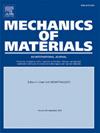Relaxation and creep responses of biological materials under spherical indentation considering surface tension
IF 3.4
3区 材料科学
Q2 MATERIALS SCIENCE, MULTIDISCIPLINARY
引用次数: 0
Abstract
For soft biological materials, indentation has been extensively utilized to evaluate their viscoelastic properties. Nevertheless, the influence of surface tension has been scarcely considered in the analysis, which might lead to a misestimation of the viscoelastic properties. In this work, for the relaxation and creep of viscoelastic solids under spherical indentation, the impact of surface tension is investigated, and the explicit relation between load and indentation depth with surface tension is established. It is revealed that the existence of surface tension leads the apparent relaxation modulus to be higher than the real one for relaxation experiments, but the contrary tendency is observed for creep compliance in creep experiments. Moreover, the relationship between indentation depth and contact radius depends also on the material properties, distinct from the conventional viscoelastic models. Furthermore, a novel avenue is proposed to determine the viscoelastic properties and surface tension simultaneously. Our results are beneficial for understanding of surface tension on relaxation and creep responses, and greatly enhance the accuracy of evaluation on the mechanical properties of soft biological materials through indentations.

求助全文
约1分钟内获得全文
求助全文
来源期刊

Mechanics of Materials
工程技术-材料科学:综合
CiteScore
7.60
自引率
5.10%
发文量
243
审稿时长
46 days
期刊介绍:
Mechanics of Materials is a forum for original scientific research on the flow, fracture, and general constitutive behavior of geophysical, geotechnical and technological materials, with balanced coverage of advanced technological and natural materials, with balanced coverage of theoretical, experimental, and field investigations. Of special concern are macroscopic predictions based on microscopic models, identification of microscopic structures from limited overall macroscopic data, experimental and field results that lead to fundamental understanding of the behavior of materials, and coordinated experimental and analytical investigations that culminate in theories with predictive quality.
 求助内容:
求助内容: 应助结果提醒方式:
应助结果提醒方式:


